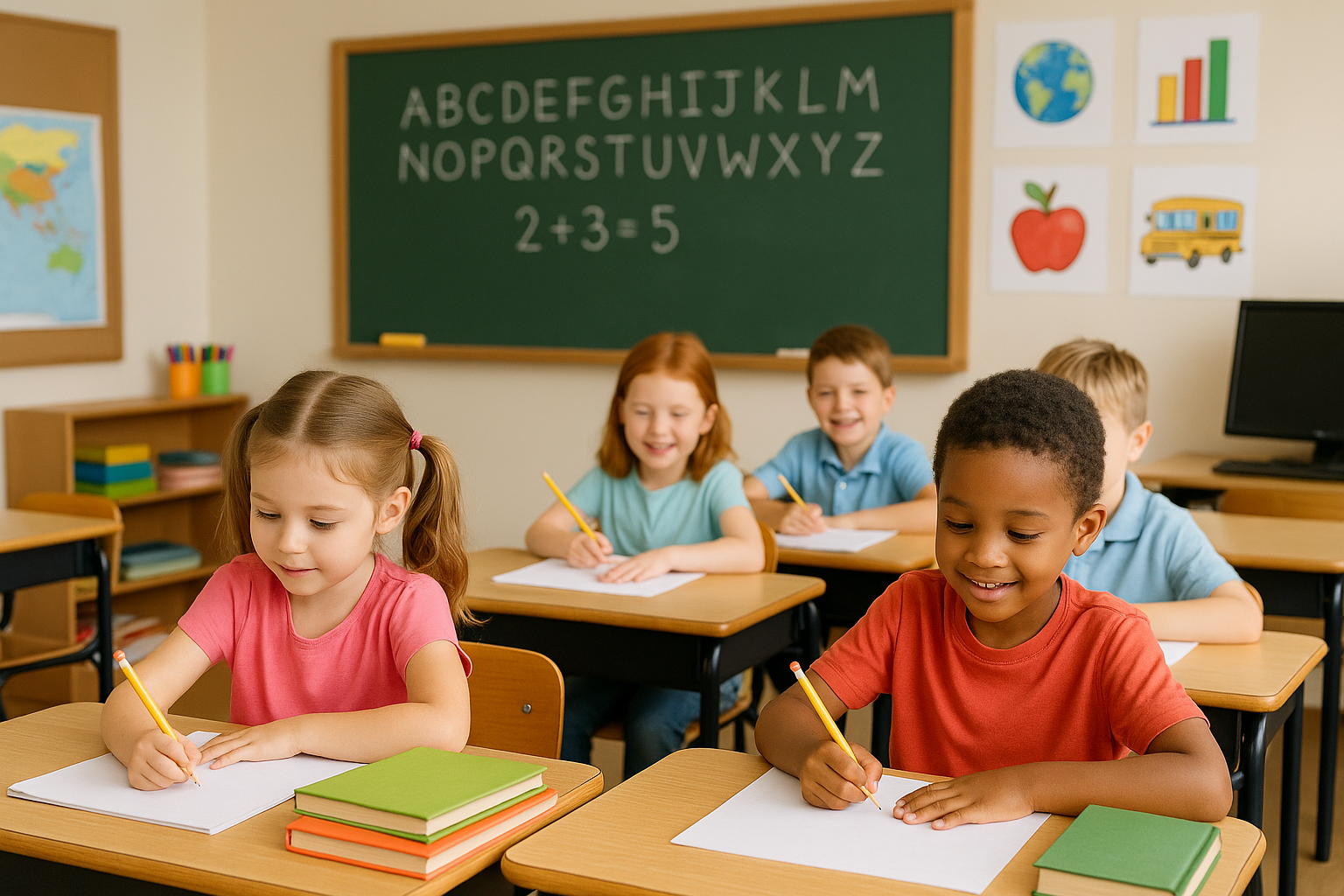British vs. American Education Systems: Understanding the Sections and Classes
Education systems vary across the globe, with notable differences between the British and American approaches. From the structure of primary education to the classes offered in college, each system has its unique features. However, both systems can generally be divided into similar stages—Primary, Middle, Secondary, and Tertiary (College/University)—though the names, age ranges, and curricular focus vary between countries.
In the U.S., the progression typically follows Elementary School (Primary), Middle School (Junior High), High School (Secondary), and then College or University (Tertiary). Meanwhile, the UK system follows Primary School, Secondary School, Sixth Form or College, and then University. Despite the naming differences, these stages serve equivalent educational purposes in preparing students for higher learning and career readiness.
Introduction

From core subjects like English and Math to electives such as Art and Technology, both the British and American education systems aim to provide students with a well-rounded education—though they differ significantly in how that curriculum is organized and delivered across various stages.
This stage-wise structure—ranging from primary to tertiary levels—not only helps in gradually building foundational knowledge but also allows for age-appropriate learning, skill development, and specialization. It ensures that students are equipped with the right competencies at the right time, preparing them effectively for higher education or the workforce.
Maintaining separate records of student progress at each educational stage is crucial for ensuring continuity, personalized learning, and informed decision-making. By tracking performance, attendance, strengths, and areas for improvement throughout primary, middle, secondary, and tertiary levels, educators and institutions can tailor support and interventions more effectively. This historical data helps in identifying trends in learning behavior, streamlining transitions between stages, and even guiding career or academic counseling. In essence, well-organized data serves as a roadmap for academic development, ensuring no student falls through the cracks.
Courses by Education Stage in British vs. American Systems
Primary Section
- UK: English, Maths, Science, History, Geography, Art, and Religious Education.
- US: English Language Arts, Mathematics, Science, Social Studies, Art, and Physical Education.
Middle Section (Junior High/Lower Secondary)
- UK: English, Maths, Sciences, Design & Technology, Modern Foreign Languages, and Citizenship.
- US: English, Pre-Algebra or Algebra, Life Science, World History, Physical Education, and Intro to Foreign Languages.
High Section (Secondary/Sixth Form or High School)
- UK: Students work towards GCSEs with courses like English Literature, Maths, Physics, Chemistry, Biology, and ICT.
- US: Courses include English (I–IV), Algebra, Geometry, Biology, U.S. History, and a wide range of electives like Business, Computer Science, or Art.
Tertiary Section (College/University)
- UK: Degree programs begin with specialized tracks (e.g., BSc Psychology, BA History).
- US: Students take general education courses alongside majors (e.g., BA in Communications, BS in Engineering).
Primary Education

British System: In the British system, primary education typically consists of Key Stages 1 and 2, covering ages 5 to 11. Subjects include English, Mathematics, Science, and others, with a focus on foundational skills. Classes included in this section are:
- Reception/Pre-School/Nursery: This is typically the first year of primary education in the British system, attended by children aged 4 to 5.
- Year 1 :Equivalent to the first grade in the American system, attended by children aged 5 to 6.
- Year 2: Second grade, ages 6 to 7.
- Year 3: Third grade, ages 7 to 8.
- Year 4: Fourth grade, ages 8 to 9.
- Year 5: Fifth grade, ages 9 to 10.
American System: In the American system, primary education spans kindergarten through 5th grade (ages 5 to 10). Common subjects include English Language Arts, Mathematics, Science, Social Studies, and Physical Education. Classes included in this section are:
- Kindergarten (K) : This is the first year of formal education in the American system, typically attended by children aged 5 to 6.
- 1st Grade : Equivalent to Year 1 in the British system, attended by children aged 6 to 7.
- 2nd Grade: Year 2, ages 7 to 8.
- 3rd Grade: Year 3, ages 8 to 9.
- 4th Grade: Year 4, ages 9 to 10.
- 5th Grade: Year 5, ages 10 to 11.
Middle School

British System: Middle school is not a distinct phase in the British system. Instead, students transition directly from primary to secondary education. Classes included in this section are:
- 6th Grade : Students aged approximately 11 to 12.
- 7th Grade: Students aged approximately 12 to 13.
- 8th Grade: Students aged approximately 13 to 14.
Note: Middle school is not a distinct phase in the British education system. Instead, students typically transition directly from primary education to secondary education without an intermediate middle school stage.
American System: Middle school in the U.S. generally includes grades 6 to 8 (ages 11 to 14). Students explore a broader range of subjects, including foreign languages, arts, and technology. Classes included in this section are:
- 6th Grade : Students aged approximately 11 to 12.
- 7th Grade: Students aged approximately 12 to 13.
- 8th Grade: Students aged approximately 13 to 14.
High School

British System: In the British system, high school is part of secondary education, comprising Key Stages 3 and 4 (ages 11 to 16). Students study for qualifications such as GCSEs (General Certificate of Secondary Education). Classes included in this section are:
- Year 9: Students aged approximately 13 to 14.
- Year 10: Students aged approximately 14 to 15.
- Year 11: Students aged approximately 15 to 16.
American System: High school in the U.S. spans grades 9 to 12 (ages 14 to 18). Students take a variety of courses, including core subjects like English, Mathematics, and Science, and elective courses based on their interests. Classes included in this section are:
- 9th Grade (Freshman): Students aged approximately 14 to 15.
- 10th Grade (Sophomore): Students aged approximately 15 to 16.
- 11th Grade (Junior): Students aged approximately 16 to 17.
- 12th Grade (Senior): Students aged approximately 17 to 18.
College/University

British System: After completing secondary education, students in the UK have the option to attend college or sixth form to pursue A-levels or vocational qualifications. University follows, offering undergraduate and postgraduate degrees. Classes included in this section are:
- First Year (Year 1): Students begin their undergraduate studies in their chosen field or degree program. This year serves as an introductory period, allowing students to explore various subjects and establish a foundation for their academic pursuits.
- Second Year (Year 2): Students progress to the second year of their undergraduate program, delving deeper into their chosen field of study and taking more specialized courses.
- Third Year (Year 3): This year marks the continuation of undergraduate studies, with students engaging in advanced coursework, research projects, and internships.
- Fourth Year (Year 4): Some degree programs in the UK may extend to a fourth year, particularly in disciplines such as engineering, medicine, or law. This year focuses on further specialization and may include a dissertation or final project.
American System: College in the U.S. refers to post-secondary education, typically lasting four years for a bachelor's degree. Students can then pursue advanced degrees through graduate school or professional programs. Classes included in this section are:
- Freshman Year (1st Year): Students begin their undergraduate studies, taking introductory courses and fulfilling general education requirements.
- Sophomore Year (2nd Year): Students progress to their second year, continuing with core coursework and exploring potential majors or areas of interest.
- Junior Year (3rd Year): This year involves more specialized coursework in the student's chosen major, along with opportunities for internships, research, or study abroad programs.
- Senior Year (4th Year): Students complete their undergraduate studies, fulfilling remaining requirements for their major and preparing for graduation.
What is the education system of Pakistan?
The education system of Pakistan is comprised of several levels, similar to many other countries. Here's a brief overview:
-
Primary Education : Primary education in Pakistan typically covers grades one through five (ages 5 to 10). It focuses on basic literacy and numeracy skills, as well as introducing students to subjects like Urdu, English, Mathematics, Science, and Social Studies.
-
Middle Education: Middle education covers grades six through eight (ages 11 to 13). Subjects become more specialized, and students delve deeper into topics like Mathematics, Science, History, Geography, and Languages.
-
Secondary Education: Secondary education consists of grades nine and ten (ages 14 to 15). Students prepare for the Matriculation or Secondary School Certificate (SSC) examinations during this phase. They study a variety of subjects and choose between science, arts, or commerce streams based on their interests and career aspirations.
-
Higher Secondary Education: After completing secondary education, students can opt for higher secondary education, which includes grades eleven and twelve (ages 16 to 17). Here, they prepare for the Higher Secondary School Certificate (HSSC) examinations. Students can specialize further in subjects like Physics, Chemistry, Biology, Mathematics, Economics, Computer Science, and others.
-
Higher Education: Upon successful completion of higher secondary education, students have the option to pursue higher education at universities, colleges, or vocational institutes. Pakistan's higher education system offers undergraduate, graduate, and postgraduate programs in various fields, including Engineering, Medicine, Business, Humanities, Social Sciences, and more.
Overall, the education system in Pakistan aims to provide students with a well-rounded education and equip them with the knowledge and skills necessary for personal and professional success. However, challenges such as inadequate infrastructure, insufficient funding, and socio-economic disparities remain significant hurdles to ensuring quality education for all citizens.
In the 1973 Constitution of Pakistan, specific references to primary education, middle education, and other levels of the education system are not explicitly outlined. Instead, the constitution provides a broader framework for education and sets forth principles and directives that guide the development and implementation of educational policies at various levels.
While the constitution emphasizes the importance of education and the state's responsibility to promote literacy and provide free and compulsory education, it does not delineate the structure of the education system into primary, middle, and other levels as we commonly understand them today.
However, the constitution does empower the state to establish educational institutions at all levels, including primary, secondary, and higher education, to ensure the provision of education to all citizens. It also grants autonomy to provinces to formulate their educational policies and programs according to their specific needs and priorities.
Therefore, while the 1973 Constitution of Pakistan does not explicitly mention primary education, middle education, etc., it provides the foundational principles upon which the education system is built, allowing for the development of a comprehensive educational framework encompassing all levels of education.
However, it is correct that despite the absence of explicit references in the constitution, Pakistan has established primary schools, middle schools, and other levels of education. The organization of the education system into primary, middle, and higher levels is a practical administrative structure developed by educational authorities to ensure the effective delivery of education to students.
While the constitution provides a broader framework for education and empowers the state to establish educational institutions at all levels, including primary and secondary, the specific organization and structure of the education system are typically determined by educational policies, regulations, and administrative decisions at the federal and provincial levels.
The establishment of primary schools to cater to younger students, middle schools to bridge the gap between primary and secondary education, and higher levels such as high schools and colleges, are part of the educational infrastructure developed over time to meet the evolving needs of the population and ensure comprehensive education for all citizens.
These administrative structures and educational levels are established through legislation, government policies, and regulations rather than being explicitly outlined in the Constitution. The constitution provides the overarching principles and guidelines for education, while the detailed organization and implementation are carried out through legislative and administrative mechanisms.
Conclusion
While both the British and American education systems aim to prepare students for success, they differ in structure and curriculum at each stage. Understanding these distinctions can help students and educators navigate their educational journeys effectively.
FAQs
1. Are there significant differences between primary education in Britain and America?
Yes, while both systems cover similar subjects, the organization and curriculum can vary.
2. How does middle school differ between the two systems?
Middle school is a distinct phase in the American system but is not separately recognized in the British system.
3. What qualifications do British students typically attain in high school?
British students often pursue GCSEs or vocational qualifications during high school.
4. Can American high school students choose their classes?
Yes, students typically have some flexibility in selecting elective courses based on their interests.
5. What is the main difference between British and American higher education?
The British system often involves specialization earlier, while the American system offers more flexibility and breadth in undergraduate education.